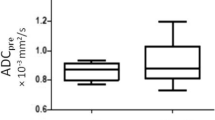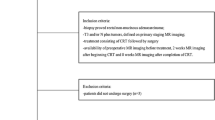Abstract
Objective
To investigate the predictive role of diffusion-weighted magnetic resonance imaging (DW-MRI) in the assessment of response to total neoadjuvant therapy (TNT) in patients with locally advanced rectal cancer (LARC).
Methods
In this single-center retrospective study, patients with LARC who underwent staging MRI and TNT were enrolled. MRI-based staging, tumor volume, and DWI-ADC values were analyzed. Patients were classified as complete responders (pCR) and non-complete responders (non-pCR), according to post-surgical outcome. Pre-treatment ADC values were compared to pathological outcome, post-treatment downstaging, and reduction of tumor volume. The diagnostic accuracy of DWI-ADC in differentiating between pCR and non-pCR groups was calculated with receiver operating characteristic (ROC) analysis.
Results
A total of 36 patients were evaluated (pCR, n = 20; non-pCR, n = 16). Pre-treatment ADC values were significantly different between the two groups (p = 0.034), while no association was found between pre-TNT tumor volume and pathological response. ADC values showed significant correlations with loco-regional downstaging after therapy (r = −0.537, p = 0.022), and with the reduction of tumor volume (r = −0.480, p = 0.044). ADC values were able to differentiate pCR from non-pCR patients with a sensitivity of 75% and specificity of 70%.
Conclusions
ADC values on pre-treatment MRI were strongly associated with the outcome in patients with LARC, both in terms of pathological response and in loco-regional downstaging after TNT, suggesting the use of DW-MRI as a potential predictive tool of response to therapy.
Key Points
• ADC values of pre-TNT MRI examinations of patients with LARC were significantly associated with a pathological complete response (pCR) and with post-treatment regression of TNM staging.
• An ADC value of 1.042 ×10 −3 mm 2 /s was found to be the optimal cutoff value for discriminating between pCR and non-pCR patients, with a sensitivity of 75% and specificity of 70%.
• DW-MRI proved to have a potential predictive role in the assessment of response to therapy in patients with LARC, throughout the analysis of ADC map values.





Similar content being viewed by others
Abbreviations
- ADC:
-
Apparent diffusion coefficient
- AUC:
-
Area under curve
- ChT:
-
Chemotherapy
- CRT:
-
Chemoradiotherapy
- DWI:
-
Diffusion-weighted imaging
- ICC:
-
Intraclass correlation coefficient
- LARC:
-
Locally advanced rectal cancer
- MRI:
-
Magnetic resonance imaging
- pCR:
-
Pathological complete response
- ROC:
-
Receiver operating characteristic
- RT:
-
Radiotherapy
- TME:
-
Total mesorectal excision
- TNT:
-
Total neoadjuvant therapy
References
Sung H, Ferlay J, Siegel RL et al (2021) Global Cancer Statistics 2020: GLOBOCAN Estimates of Incidence and Mortality Worldwide for 36 Cancers in 185 Countries. CA Cancer J Clin 71:209–249. https://doi.org/10.3322/caac.21660
Ouyang G, Yang X, Deng X et al (2021) Predicting response to total neoadjuvant treatment (TNT) in locally advanced rectal cancer based on multiparametric magnetic resonance imaging: a retrospective study. Cancer Manag Res 13:5657–5669. https://doi.org/10.2147/CMAR.S311501
Cercek A, Roxburgh CSD, Strombom P et al (2018) Adoption of total neoadjuvant therapy for locally advanced rectal cancer. JAMA Oncol 4:e180071. https://doi.org/10.1001/jamaoncol.2018.0071
Ludmir EB, Palta M, Willett CG, Czito BG (2017) Total neoadjuvant therapy for rectal cancer: an emerging option. Cancer 123. https://doi.org/10.1002/cncr.30600
Koh D-M, Collins DJ (2007) Diffusion-weighted MRI in the body: applications and challenges in oncology. AJR Am J Roentgenol 188:1622–1635. https://doi.org/10.2214/AJR.06.1403
Eisenhauer EA, Therasse P, Bogaerts J et al (2009) New response evaluation criteria in solid tumours: revised RECIST guideline (version 1.1). Eur J Cancer 45:228–247. https://doi.org/10.1016/j.ejca.2008.10.026
Heald RJ, Ryall RD (1986) Recurrence and survival after total mesorectal excision for rectal cancer. Lancet 1:1479–1482. https://doi.org/10.1016/s0140-6736(86)91510-2
De Felice F, D’Ambrosio G, Iafrate F et al (2021) Intensified total neoadjuvant therapy in patients with locally advanced rectal cancer: a phase II trial. Clin Oncol (R Coll Radiol) 33:788–794. https://doi.org/10.1016/j.clon.2021.06.006
Amin MB, Edge S, Greene F et al (2017) AJCC Cancer Staging Manual, 8th edn. Springer International Publishing
Nioche C, Orlhac F, Boughdad S et al (2018) LIFEx: a freeware for radiomic feature calculation in multimodality imaging to accelerate advances in the characterization of tumor heterogeneity. Cancer Res 78:4786–4789. https://doi.org/10.1158/0008-5472.CAN-18-0125
Riesco-Martinez MC, Fernandez-Martos C, Gravalos-Castro C et al (2020) Impact of total neoadjuvant therapy vs. standard chemoradiotherapy in locally advanced rectal cancer: a systematic review and meta-analysis of randomized trials. Cancers (Basel) 12:E3655. https://doi.org/10.3390/cancers12123655
Petrelli F, Trevisan F, Cabiddu M et al (2020) Total neoadjuvant therapy in rectal cancer: a systematic review and meta-analysis of treatment outcomes. Ann Surg 271:440–448. https://doi.org/10.1097/SLA.0000000000003471
Dizdarevic E, Frøstrup Hansen T, Pløen J et al (2020) Long-term patient-reported outcomes after high-dose chemoradiation therapy for nonsurgical management of distal rectal cancer. Int J Radiat Oncol Biol Phys 106:556–563. https://doi.org/10.1016/j.ijrobp.2019.10.046
Kim SH, Lee JM, Hong SH et al (2009) Locally advanced rectal cancer: added value of diffusion-weighted MR imaging in the evaluation of tumor response to neoadjuvant chemo- and radiation therapy. Radiology 253:116–125. https://doi.org/10.1148/radiol.2532090027
Dzik-Jurasz A, Domenig C, George M et al (2002) Diffusion MRI for prediction of response of rectal cancer to chemoradiation. Lancet 360:307–308. https://doi.org/10.1016/S0140-6736(02)09520-X
Lambregts DMJ, Delli Pizzi A, Lahaye MJ et al (2018) A pattern-based approach combining tumor morphology on MRI with distinct signal patterns on diffusion-weighted imaging to assess response of rectal tumors after chemoradiotherapy. Dis Colon Rectum 61:328–337. https://doi.org/10.1097/DCR.0000000000000915
Zhao M, Zhao L, Yang H et al (2021) Apparent diffusion coefficient for the prediction of tumor response to neoadjuvant chemo-radiotherapy in locally advanced rectal cancer. Radiat Oncol 16:17. https://doi.org/10.1186/s13014-020-01738-6
Jung SH, Heo SH, Kim JW et al (2012) Predicting response to neoadjuvant chemoradiation therapy in locally advanced rectal cancer: diffusion-weighted 3 tesla MR imaging. J Magn Reson Imaging 35:110–116. https://doi.org/10.1002/jmri.22749
Amodeo S, Rosman AS, Desiato V et al (2018) MRI-based apparent diffusion coefficient for predicting pathologic response of rectal cancer after neoadjuvant therapy: systematic review and meta-analysis. AJR Am J Roentgenol 211:W205–W216. https://doi.org/10.2214/AJR.17.19135
Yuan Y, Zeng D, Liu Y et al (2020) DWI and IVIM are predictors of Ki67 proliferation index: direct comparison of MRI images and pathological slices in a murine model of rhabdomyosarcoma. Eur Radiol 30:1334–1341. https://doi.org/10.1007/s00330-019-06509-w
Zhang X-Y, Sun Y-S, Tang L et al (2011) Correlation of diffusion-weighted imaging data with apoptotic and proliferation indexes in CT26 colorectal tumor homografts in Balb/c mouse. J Magn Reson Imaging 33:1171–1176. https://doi.org/10.1002/jmri.22558
Williams GH, Stoeber K (2012) The cell cycle and cancer. J Pathol 226:352–364. https://doi.org/10.1002/path.3022
Lambregts DMJ, Lahaye MJ, Heijnen LA et al (2016) MRI and diffusion-weighted MRI to diagnose a local tumour regrowth during long-term follow-up of rectal cancer patients treated with organ preservation after chemoradiotherapy. Eur Radiol 26:2118–2125. https://doi.org/10.1007/s00330-015-4062-z
Lambregts DMJ, van Heeswijk MM, Delli Pizzi A et al (2017) Diffusion-weighted MRI to assess response to chemoradiotherapy in rectal cancer: main interpretation pitfalls and their use for teaching. Eur Radiol 27:4445–4454. https://doi.org/10.1007/s00330-017-4830-z
Sassen S, de Booij M, Sosef M et al (2013) Locally advanced rectal cancer: is diffusion weighted MRI helpful for the identification of complete responders (ypT0N0) after neoadjuvant chemoradiation therapy? Eur Radiol 23:3440–3449. https://doi.org/10.1007/s00330-013-2956-1
Napoletano M, Mazzucca D, Prosperi E et al (2019) Locally advanced rectal cancer: qualitative and quantitative evaluation of diffusion-weighted magnetic resonance imaging in restaging after neoadjuvant chemo-radiotherapy. Abdom Radiol (NY) 44:3664–3673. https://doi.org/10.1007/s00261-019-02012-4
Pham TT, Liney G, Wong K et al (2021) Multi-parametric magnetic resonance imaging assessment of whole tumour heterogeneity for chemoradiotherapy response prediction in rectal cancer. Phys Imaging Radiat Oncol 18:26–33. https://doi.org/10.1016/j.phro.2021.03.003
Baucom RB, Maguire LH, Kavalukas SL et al (2017) Nodal disease in rectal cancer patients with complete tumor response after neoadjuvant chemoradiation: danger below calm waters. Dis Colon Rectum 60:1260–1266. https://doi.org/10.1097/DCR.0000000000000947
Newton AD, Li J, Jeganathan AN et al (2016) A nomogram to predict lymph node positivity following neoadjuvant chemoradiation in locally advanced rectal cancer. Dis Colon Rectum 59:710–717. https://doi.org/10.1097/DCR.0000000000000638
Acknowledgements
We would like to acknowledge all the colleagues of the Department of Radiological, Oncological and Pathological Sciences, the Department of Radiotherapy, and the Department of General Surgery of Policlinico Umberto I Hospital for patients’ management and their contribution to this manuscript.
Funding
The authors state that this work has not received any funding.
Author information
Authors and Affiliations
Corresponding author
Ethics declarations
Guarantor
The scientific guarantor of this publication is Franco Iafrate.
Conflict of interest
The authors of this manuscript declare no relationships with any companies whose products or services may be related to the subject matter of the article
Statistics and biometry
No complex statistical methods were necessary for this paper.
Informed consent
Written informed consent was waived due to the retrospective nature of the study.
Ethical approval
This study was approved by the local ethic committee.
Methodology
• retrospective
• diagnostic or prognostic study
• performed at one institution
Additional information
Publisher’s note
Springer Nature remains neutral with regard to jurisdictional claims in published maps and institutional affiliations.
Rights and permissions
Springer Nature or its licensor holds exclusive rights to this article under a publishing agreement with the author(s) or other rightsholder(s); author self-archiving of the accepted manuscript version of this article is solely governed by the terms of such publishing agreement and applicable law.
About this article
Cite this article
Iafrate, F., Ciccarelli, F., Masci, G.M. et al. Predictive role of diffusion-weighted MRI in the assessment of response to total neoadjuvant therapy in locally advanced rectal cancer. Eur Radiol 33, 854–862 (2023). https://doi.org/10.1007/s00330-022-09086-7
Received:
Revised:
Accepted:
Published:
Issue Date:
DOI: https://doi.org/10.1007/s00330-022-09086-7




